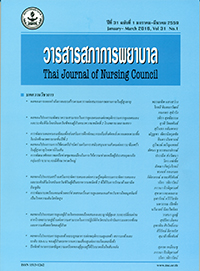การพัฒนาแผลหนองเทียมเพื่อส่งเสริมการฝึกทักษะการเก็บสิ่งคัดหลั่ง จากแผลเพาะเชื้อ ในนักศึกษาพยาบาลชั้นปีที่ 2
Keywords:
แผลหนองเทียม, การเก็บสิ่งคัดหลั่งจากแผลเพาะเชื้อ, นักศึกษาพยาบาล, artificial pus wound model, wound swab culture, nursing studentsAbstract
บทคัดย่อ: วัตถุประสงค์การวิจัย: เพื่อพัฒนาแผลหนองเทียมสำหรับนักศึกษาพยาบาล ใช้ฝึกทักษะการเก็บสิ่งคัดหลั่งจากแผลเพาะเชื้อในห้องปฏิบัติการพยาบาล และเพื่อประเมิน ประสิทธิผลของแผลหนองเทียม
การออกแบบการวิจัย: งานวิจัยและพัฒนา
การดำเนินการวิจัย: แบ่งออกเป็น 3 ระยะ คือ ระยะที่ 1 สร้างและพัฒนาแผลหนองเทียม ระยะที่ 2 สร้างและพัฒนาแบบประเมินความพึงพอใจและความมั่นใจของผู้ใช้แผลหนองเทียม ระยะที่ 3 ประเมินประสิทธิผลของแผลหนองเทียม กลุ่มตัวอย่างเลือกแบบเจาะจง เป็นนักศึกษา พยาบาลชั้นปีที่ 2 จำนวน 165 คน เครื่องมือที่ใช้ในการวิจัยประกอบด้วย 1) แผลหนองเทียม และ 2) แบบประเมินความพึงพอใจและความมั่นใจของผู้ใช้แผลหนองเทียม เก็บรวบรวม ข้อมูลโดยวัดความพึงพอใจและความมั่นใจของผู้ใช้แผลหนองเทียมภายหลังฝึกทักษะ และผ่านการประเมินทักษะจากผู้วิจัย วิเคราะห์ข้อมูลโดยใช้สถิติบรรยาย
ผลการวิจัย: การประเมินความพึงพอใจของนักศึกษาพยาบาลผู้ใช้แผลหนองเทียม จำนวน 165 คน พบว่า ในด้านลักษณะภายนอกของแผลหนองเทียม นักศึกษาพยาบาลให้ คะแนนอยู่ในระดับพอใจมาก (Mean = 3.33, SD = .41) ด้านความมีคุณค่า (Mean = 3.68, SD = .24) และด้านความคิดสร้างสรรค์ในการประดิษฐ์แผลหนองเทียม (Mean = 3.82, SD = .39) อยู่ในระดับพอใจมากที่สุด สำหรับการประเมินความมั่นใจต่อการฝึกทักษะโดยใช้ แผลหนองเทียม อยู่ในระดับพอใจมากที่สุด (Mean = 3.78, SD = .41) สรุปได้ว่า แผลหนองเทียม ที่พัฒนาขึ้นเป็นแบบจำลองการฝึกทักษะที่สมจริง เหมาะสำหรับใช้ฝึกในห้องปฏิบัติการ ช่วยให้นักศึกษามีความมั่นใจต่อการฝึกทักษะการเก็บสิ่งคัดหลั่งจากแผลเพาะเชื้อ
ข้อเสนอแนะ: ส่งเสริมให้นำแผลหนองเทียมไปใช้ฝึกทักษะการทำแผลประเภท อื่น เช่น การทำแผลระบบปิดแบบสูญญากาศ หรือนำมาต่อกับสายระบายเพื่อเพิ่มโอกาส ให้นักศึกษาได้ฝึกทักษะการทำแผลในหลากหลายรูปแบบ
Abstract: Objective: To develop an artificial pus wound model to help second-year
nursing students perform wound swab culture.
Design: Research and development.
Implementation: The study was conducted in 3 stages: model design and development;
satisfaction and confidence scale development; and model efficacy evaluation. The
participants, purposively sampled, were 165 second-year nursing students. The research
instruments consisted of (1) an artificial pus wound model and (2) a participant satisfaction
and confidence scale. The data on the participants’ satisfaction and confidence with the
model were collected after the participants’ skill was evaluated by the researcher at the
end of the training session. The data were analysed using descriptive statistics.
Results: Averagely, the 165 participants showed a very high degree of satisfaction
with the artificial pus wound model in terms of its external features (mean = 3.33, SD =
.41) and its worthiness (mean = 3.68, SD = .24), and displayed the highest degree of
satisfaction with the creativity aspect of the model (mean = 3.82, SD = .39). In terms of
their application confidence, the participants in general rated the model as being most
satisfactory (mean = 3.78, SD = .41). It can be concluded, therefore, that the developed
artificial pus wound model was a realistic tool for skill training and could be practiced
in laboratory settings to help nursing students improve their confidence in collecting
secreted substances for culturing purposes.
Recommendations: It is recommended that the artificial pus wound model be
applied to other forms of wound dressing, such as wound dressing in a vacuum system,
or be connected to a ventilation system for better treatment. Such application could
familiarise nursing students with diverse methods of dressing wounds.
Downloads
References
Caliskan N, Ozturk D, Baykara ZG, Korkut H,
Karadag A. The effect of periodic training on the
clinical application of nursing students’ psychomotor
skills. Procedia - Social and Behavioral Sciences.
;47:786-91.
Karabulut SD, Ulusoy MF. Students’ views on clinical
practice of fundamentals of nursing course. Sağlık
Bilimleri Fakültesi Hemşirelik Dergisi. 2008:26-40.
Öztürk D, Çalışkan N, Baykara ZG, Karadağ A,
Karabulut H. Determining the effect of periodic
training on the basic psychomotor skills of nursing
students. Nurse Educ Today. 2015;35(2):402-7.
Sears K, Goldsworthy S, Goodman WM. The relationship
between simulation in nursing education and medication
safety. J Nurs Educ. 2010;49(1):52-5.
Spear M. Best technique for obtaining wound cultures.
Plast Surg Nurs. 2012;32(1):34-6.
Haraldseid C, Friberg F, Aase K. Nursing students’
perceptions of factors influencing their learning
environment in a clinical skills laboratory: A qualitative
study. Nurse Educ Today. 2015;35(9):e1-e6.
Ruangdee Chevasutho. Relationship between teaching
quality, learning behaviour and learning efficacy as
observed amongst third-year nursing science majors
at Boromarajonani college of nursing, Chon Buri.
TJNC. 2012;27(4):43-56.
Ando M. Effects of self monitoring of nursing students
on Anxiety or Self-efficacy in practical training.
Ann Gunma Health Sci. 2004;24:1-5.
Cole FL, Ramirez EG. Beef tongue: A model for
teaching complex wound closure to emergency nurse
practitioner students. J Emerg Nurs. 2002;28(5):
-8.
Lutz JB, Zehrer CL, Solfest SE, Walters S-A. A
new in vivo test method to compare wound dressing
fluid handling characteristics and wear time. Ostomy
Wound Manage. 2011;57(8):28–36.
Durham CF, Alden KR. Enhancing patient safety in
nursing education through patient simulation In:
Hughes RG, editor. Patient safety and quality: An
evidence-based handbook for nurses. Rockville
MD2008.
Horwath J, Morrison T. Effective staff training in
social care: From theory to practice. London and
New York: Routledge; 1999.
Bonham PA. Swab cultures for diagnosing wound
infections: A literature review and clinical guideline.
J Wound Ostomy Continence Nurs. 2009;36(4):
-95.
Kockrow EO. Medical-surgical asepsis and infection
prevention and control. In: Christensen BL, Kockrow
EO, editors. Foundations of nursing. 6 ed. St. Louis,
Missouri: Mosby Elsevier; 2011. p. 266-309.
Rothgeb MK. Creating a Nursing Simulation
Laboratory: A Literature Review. J Nurs Educ.
;47(11):489-94.
Bowling AM. The effect of simulation on skill
performance: A need for change in pediatric nursing
education. J Pediatr Nurs. 2015;30: 439–46.
12 Brain/mind natural learning principles [Internet].
[cited July 16, 2015]. Available from: http://
www.cainelearning.com/wp-content/uploads/
/04/12-Brainmind-principles-expanded.pdf.
Duman B. The effects of brain-based learning on
the academic achievement of students with different
learning styles. Educational Sciences: Theory &
Practice. 2010;10(4):2077-103.
Ross JG. The effect of simulation training on
baccalaureate nursing students’ competency in
performing intramuscular injection. Nurs Educ
Perspect. 2015;36(1):48-9.







